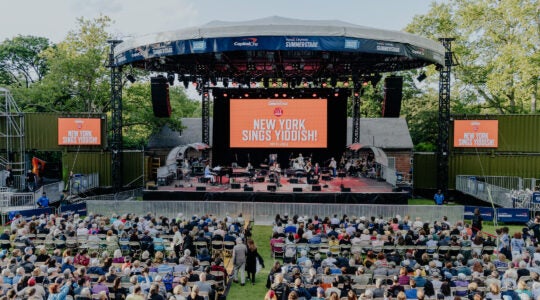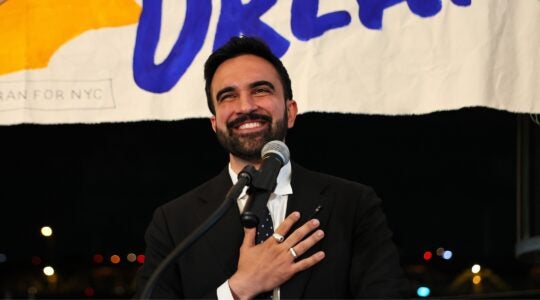A station wagon driven by an Orthodox Jew, allegedly running a red light, is involved in an early evening, late August accident with two African Americans on the streets of Brooklyn.
This scenario happened in 1991, when Yosef Lifsh’s car, in a motorcade escorting the Lubavitcher rebbe, spun out of control in Crown Heights and jumped a curb, killing 7-year-old Gavin Cato and injuring his 7-year-old cousin Angela. Crown Heights erupted in anti-Jewish riots.
In Flatbush on Sunday, another accident occurred: a fatal crash between a Hatzoloh vehicle driven by Shamai Goldstein, a volunteer for the Jewish ambulance service, and a motorcycle ridden by Alberto Curtis, 37, and his 13-year-old son, Alberto Jr. Curtis and his son were killed.
Flatbush remained calm. No riots, no rallies, no fingers pointed at the Jewish community.
This week’s response to a potentially incendiary tragedy, representatives of New York’s Jewish and black communities say, is the result of differences in the accidents’ circumstances, the varied natures of the two racially mixed neighborhoods, and changes in relations between the two ethnic groups: changes brought about, in part, by the Crown Heights riots.
"It’s a different time," said Ed Sederbaum, associate director of the Anti-Defamation League’s New York region.
The ADL is among several local and national Jewish organizations that have sponsored a series of dialogue activities at the grassroots and leadership levels in the last nine years.
"We have a far different relationship with the [minority] residents of Crown Heights and other areas of Brooklyn because of the Crown Heights incident," Sederbaum said. "We have real relationships" based on such mutual efforts as lobbying for a state Hate Crimes Bill.
"We know each other well. Those are the kinds of relationships that breed respect."
In addition, he said, an individual’s automobile caused the 1991 deaths, while Goldstein’s station wagon was clearly identified as an emergency medical vehicle.
"There’s a difference between a private car and an ambulance," Sederbaum said. "It’s very hard to say that the driver of an ambulance is selfish," charges made against Lifsh in 1991.
"In 1991 you had a buildup" of resentment of Crown Heights residents, said Richard Green, chief executive officer of the Crown Heights Youth Collective. He patrolled the neighborhood during the riots, and when tensions threatened to flare anew in subsequent months, he preached against violence.
Today, Green said, he does not find "the sort of attitudes based on misinformation. It’s a better tenor of relations with the police and district attorney. The community is much more sensitive to the law, waiting to see what will happen … where does the culpability lie."
The four-day Crown Heights riots that followed the traffic accident on Aug. 19, 1991, occurred in a neighborhood with a long history of frayed relations between blacks and the outnumbered, insular chasidic community.
Rumors, later refuted, that Hatzoloh members refused to treat the two black children injured by Lifsh’s car fueled the anger of black rioters.
In Flatbush, says Rabbi Yechezkel Pikus, executive director of the Council of Jewish Organizations of Flatbush, "The Jews are not as intermingled with the blacks," and neither group sees itself in direct competition with the other for housing or other resources.
"There isn’t the general hostility," Rabbi Pikus says, adding that blacks and Jews cooperate in Flatbush on security patrols and community health programs. "You don’t have that militancy."
The Crown Heights riots, and a perceived climate of mistrust between American Jews and blacks, spurred an array of fence-building activities, including those of Rabbi Marc Schneier’s Coalition for Mutual Understanding, the ADL’s "A World Of Difference" diversity program, Project CURE’s social and athletic initiative for Crown Heights teens, and the assistance Hatzoloh offered to a new black ambulance corps in Brooklyn’s Bedford-Stuyvesant neighborhood.
Another ADL program, "Mothers to Mothers," based in Crown Heights, was designed to improve intragroup relations between families, Sederbaum said. "The reputation of those type of things spread."
This week’s fatalities were the first involving a Hatzoloh vehicle in the organization’s more than 30 years, a Hatzoloh spokesman said. With 45 ambulances in New York City, the Jewish corps makes some 200,000 runs a year, the spokesman said.
Goldstein, 36, a certified critical-care technician, driving his 1988 Ford station wagon outfitted with a siren and flasher, was answering an emergency call from an elderly woman with chest pains Sunday at about 8 p.m. His vehicle has VAS (volunteer ambulance service) plates.
At the corner of Ocean Avenue and Avenue L, his station wagon and the Curtis motorcycle collided.
While early reports indicated that Goldstein ran a red light and struck the Curtis vehicle, a Hatzoloh spokesman said Goldstein had stopped at the corner and the motorcycle hit the station wagon. Curtis, trying out a friend’s Yamaha Y2F-600, reportedly did not have a special motorcycle license.
An medical emergency vehicle on call, such as Goldstein’s, may go through a stop sign or red light after "slowing down as may be necessary" to observe oncoming traffic, according to the state Vehicle Traffic Law.
Frank Daly Jr., attorney for the Curtis family, said the accident victims’ relatives may sue Hatzoloh.
Both motorcycle riders wore helmets. The collision threw them off the bike. Curtis, a subway conductor, was pronounced dead at Maimonides Medical Center. His son, a ninth-grader who played tenor drum with the First Panamanian Drum and Bugle Corps, was rushed to Kings County Hospital, where he died. Both were taken to the hospital by Hatzoloh units.
"It’s obviously a tragedy. These were all persons who lead good lives," Sederbaum of the ADL said.
Another Hatzoloh crew treated the woman who reported the chest pains.
Goldstein, a "member in good standing" of Hatzoloh who has a clean driving record, faces no charges in the accident, police said. He was treated for trauma at Lutheran Medical CenterPolice and the state Health Department are investigating the accident.
The New York Jewish Week brings you the stories behind the headlines, keeping you connected to Jewish life in New York. Help sustain the reporting you trust by donating today.




